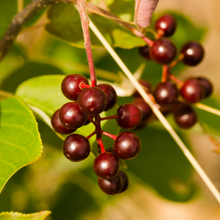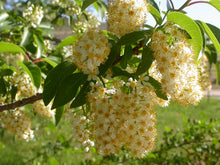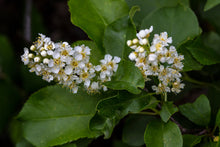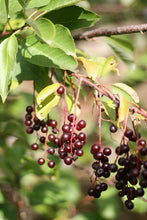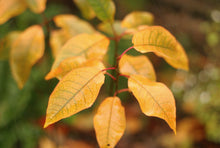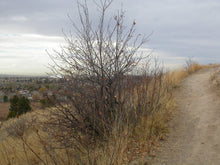
Prunus virginiana
Chokecherry is a small tree or large shrub (aka an arborescent shrub) with an upright form that provides year-round interest in the habitat garden. Its deciduous foliage emerges dark and glossy in early spring from dark-reddish, brown branches. By April or May, long-cylindrical clusters of creamy white, pleasantly-fragrant flowers dangle in the breeze, beckoning and supporting pollinators.
In fall, the leaves offer hues of yellow, gold and even red while its edible deep purple-to-black sour chokecherries are a beloved and nutrient-packed food source for birds, small mammals, and bears and an excellent (albeit sour) choice for jams and wine.
- Plant type/canopy layer: deciduous, perennial, small tree or large shrub
- Size at maturity: 15-35' tall, 15-20' wide
- Light requirements: full sun, part-sun/part-shade
- Moisture requirements: seasonally wet, moist to dry soil
- Bloom time: April - July
- Growth rate/ease: grows quickly, very easy to grow
- Wildlife support: flowers attract and provide nectar to hummingbirds, adult butterflies (pale swallowtail, silvery blue, spring azure, and painted lady), bees and other insect pollinators; fruits are adored by and an important source of food for backyard birds (more than 30 species of birds are known to eat it in the Portland metro area), as well as small mammals, bears and humans; young twigs and foliage are grazed by deer and elk; overall plant attracts and supports beneficial and other pest eating insects and is a caterpillar host plant and larval food source for native butterflies and moths including Lorquin's Admiral and Tiger Swallowtail.
- Native habitat/range: found on rocky slopes, along streams, in wooded areas and forest edges, at low to mid-elevations, throughout western North America excluding Alaska. In the Pacific Northwest, although more common on the east side of the Cascades, it can be found west of the Cascades, often in drier, prairie habitats. Portland Plant List - yes.
- Special features & uses: hummingbird, pollinator and wildlife magnet; edible berries, though they contain trace amounts of cyanide that diminishes as they mature - so select the darkest ones, in moderation; medicinal; landscape uses include pollinator gardens, rock gardens, woodland gardens, erosion control, habitat hedgerows and windbreaks/screens
Gardening with Common Chokecherry: This deciduous tree/shrub is exceptionally easy to grow and packs a formidable punch as a wildlife plant. It tolerates pretty much any soil type and moisture, as well as a range of light exposures except deep shade. That said, it will flower more with more sunlight. It also wants to become a small grove or thicket and will send up suckers that are a welcomed addition for folks trying to revegetate an oversized property and/or are interested in creating a large habitat-haven. On smaller, more tightly manicured properties, suckers can be controlled by cutting them back or ripping them out as they regularly emerge.
Photo Credit 1: "Common Chokeberry (Prunus virginiana)" by wackybadger is licensed under CC BY-SA 2.0
Photo Credit 2 & 6: "Prunus virginiana" by Matt Lavin is licensed under CC BY-SA 2.0
Photo Credit 3: "Chokecherry - Prunus virginiana" by Rocky Mountain National Park is licensed under CC BY-ND 2.0
Photo Credits 4 & 5: Karli Del Biondo, Beetles and Bees
Photo Credit 6: "Prunus virginiana" by Matt Lavin is licensed under CC BY-SA 2.0






